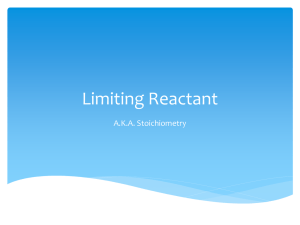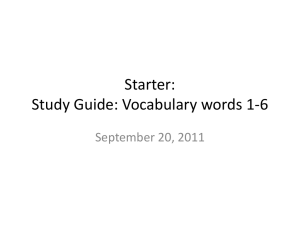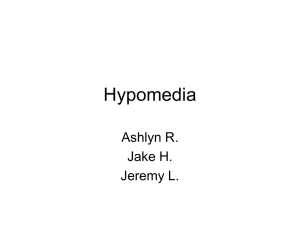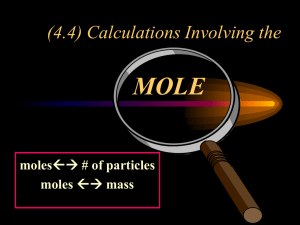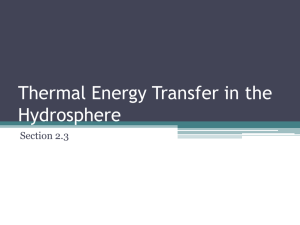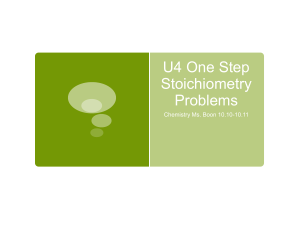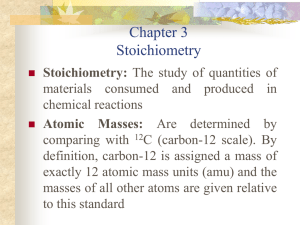CHEMICAL REACTIONS Chapter 4
advertisement
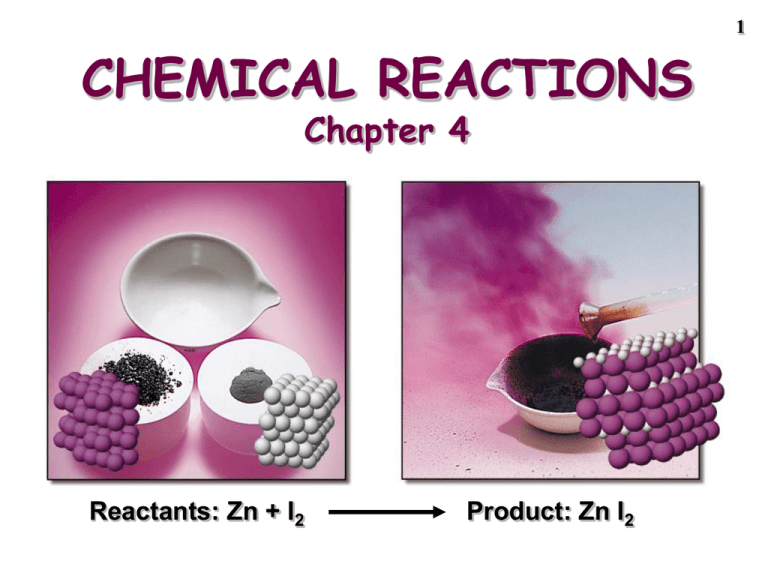
1 CHEMICAL REACTIONS Chapter 4 Reactants: Zn + I2 Product: Zn I2 2 Chemical Equations Depict the kind of reactants and products and their relative amounts in a reaction. 4 Al(s) + 3 O2(g) ---> 2 Al2O3(s) The numbers in the front are called stoichiometric coefficients The letters (s), (g), and (l) are the physical states of compounds. Chemical Equations 4 Al(s) + 3 O2(g) ---> 2 Al2O3(s) This equation means 4 Al atoms + 3 O2 molecules ---give---> 2 molecules of Al2O3 4 moles of Al + 3 moles of O2 ---give---> 2 moles of Al2O3 3 Chemical Equations • Because the same atoms are present in a reaction at the beginning and at the end, the amount of matter in a system does not change. • The Law of the Conservation of Matter Demo of conservation of matter, See Screen 4.3. 4 Chemical Equations Because of the principle of the conservation of matter, an equation must be balanced. It must have the same number of atoms of the same kind on both sides. Lavoisier, 1788 5 6 Balancing Equations ___ Al(s) + ___ Br2(liq) ---> ___ Al2Br6(s) 7 Balancing Equations ____C3H8(g) + _____ O2(g) ----> _____CO2(g) + _____ H2O(g) ____B4H10(g) + _____ O2(g) ----> ___ B2O3(g) + _____ H2O(g) 8 STOICHIOMETRY - the study of the quantitative aspects of chemical reactions. STOICHIOMETRY It rests on the principle of the conservation of matter. 2 Al(s) + 3 Br2(liq) ------> Al2Br6(s) 9 PROBLEM: If 454 g of NH4NO3 decomposes, how much N2O and H2O are formed? What is the theoretical yield of products? STEP 1 Write the balanced chemical equation NH4NO3 ---> N2O + 2 H2O 10 11 454 g of NH4NO3 --> N2O + 2 H2O STEP 2 Convert mass reactant (454 g) --> moles 1 mol 454 g • = 5.68 mol NH4NO3 80.04 g STEP 3 Convert moles reactant (5.68 mol) --> moles product 12 454 g of NH4NO3 --> N2O + 2 H2O STEP 3 Convert moles reactant --> moles product Relate moles NH4NO3 to moles product expected. 1 mol NH4NO3 --> 2 mol H2O Express this relation as the STOICHIOMETRIC FACTOR. 2 mol H2 O produced 1 mol NH4NO3 used 13 454 g of NH4NO3 --> N2O + 2 H2O STEP 3 Convert moles reactant (5.68 mol) --> moles product 2 mol H2O produced 5.68 mol NH4NO3 • 1 mol NH4NO3 used = 11.4 mol H2O produced 14 454 g of NH4NO3 --> N2O + 2 H2O STEP 4 Convert moles product (11.4 mol) --> mass product Called the THEORETICAL YIELD 18.02 g 11.4 mol H2O • = 204 g H2O 1 mol ALWAYS FOLLOW THESE STEPS IN SOLVING STOICHIOMETRY PROBLEMS! GENERAL PLAN FOR STOICHIOMETRY CALCULATIONS Mass product Mass reactant Moles reactant Stoichiometric factor Moles product 15 16 454 g of NH4NO3 --> N2O + 2 H2O STEP 5 How much N2O is formed? Total mass of reactants = total mass of products 454 g NH4NO3 = ___ g N2O + 204 g H2O mass of N2O = 250. g 17 454 g of NH4NO3 --> N2O + 2 H2O STEP 6 Calculate the percent yield If you isolated only 131 g of N2O, what is the percent yield? This compares the theoretical (250. g) and actual (131 g) yields. 18 454 g of NH4NO3 --> N2O + 2 H2O STEP 6 Calculate the percent yield actual yield % yield = • 100% theoretical yield 131 g % yield = • 100% = 52.4% 250. g PROBLEM: Using 5.00 g of H2O2, what mass of O2 and of H2O can be obtained? 2 H2O2(liq) ---> 2 H2O(g) + O2(g) Reaction is catalyzed by MnO2 Step 1: moles of H2O2 Step 2: use STOICHIOMETRIC FACTOR to calculate moles of O2 Step 3: mass of O2 19 Reactions Involving a LIMITING REACTANT • In a given reaction, there is not enough of one reagent to use up the other reagent completely. • The reagent in short supply LIMITS the quantity of product that can be formed. 20 LIMITING REACTANTS Reactants 2 NO(g) + O2 (g) Products 2 NO2(g) Limiting reactant = ___________ Excess reactant = ____________ 21 22 LIMITING REACTANTS Demo of limiting reactants on Screen 4.7 LIMITING REACTANTS (See CD Screen 4.8) React solid Zn with 0.100 mol HCl (aq) Zn + 2 HCl ---> ZnCl2 + H2 1 2 3 Rxn 1: Balloon inflates fully, some Zn left * More than enough Zn to use up the 0.100 mol HCl Rxn 2: Balloon inflates fully, no Zn left * Right amount of each (HCl and Zn) Rxn 3: Balloon does not inflate fully, no Zn left. 23 LIMITING REACTANTS React solid Zn with 0.100 mol HCl (aq) Zn + 2 HCl ---> ZnCl2 + H2 mass Zn (g) mol Zn mol HCl mol HCl/mol Zn Lim Reactant Rxn 1 7.00 0.107 0.100 0.93/1 LR = HCl Rxn 2 3.27 0.050 0.100 2.00/1 no LR Rxn 3 1.31 0.020 0.100 5.00/1 LR = Zn 24 25 Reaction to be Studied 2 Al + 3 Cl2 ---> Al2Cl6 26 PROBLEM: Mix 5.40 g of Al with 8.10 g of Cl2. What mass of Al2Cl6 can form? Mass product Mass reactant Moles reactant Stoichiometric factor Moles product 27 Step 1 of LR problem: compare actual mole ratio of reactants to theoretical mole ratio. Step 1 of LR problem: compare actual mole ratio of reactants to theoretical mole ratio. 2 Al + 3 Cl2 ---> Al2Cl6 Reactants must be in the mole ratio mol Cl2 3 = mol Al 2 28 Deciding on the Limiting Reactant 2 Al + 3 Cl2 ---> Al2Cl6 If mol Cl2 3 > mol Al 2 There is not enough Al to use up all the Cl2 Lim reag = Al 29 Deciding on the Limiting Reactant 2 Al + 3 Cl2 ---> Al2Cl6 If mol Cl2 3 < mol Al 2 There is not enough Cl2 to use up all the Al Lim reag = Cl2 30 31 Step 2 of LR problem: Calculate moles of each reactant We have 5.40 g of Al and 8.10 g of Cl2 1 mol 5.40 g Al • = 0.200 mol Al 27.0 g 1 mol 8.10 g Cl2 • = 0.114 mol Cl2 70.9 g Find mole ratio of reactants 2 Al + 3 Cl2 ---> Al2Cl6 mol Cl2 0.114 mol = = 0.57 mol Al 0.200 mol This would be 3/2, or 1.5/1, if reactants are present in the exact stoichiometric ratio. Limiting reagent is Cl2 32 Mix 5.40 g of Al with 8.10 g of Cl2. What mass of Al2Cl6 can form? 2 Al + 3 Cl2 ---> Al2Cl6 Limiting reactant = Cl2 Base all calcs. on Cl2 grams Cl2 moles Cl2 grams Al2Cl6 1 mol Al2Cl6 3 mol Cl2 moles Al2Cl6 33 CALCULATIONS: calculate mass of Al2Cl6 expected. Step 1: Calculate moles of Al2Cl6 expected based on LR. 1 mol Al2Cl6 0.114 mol Cl2 • = 0.0380 mol Al2Cl6 3 mol Cl2 Step 2: Calculate mass of Al2Cl6 expected based on LR. 0.0380 mol Al2Cl6 • 266.4 g Al2Cl6 = 10.1 g Al2Cl6 mol 34 35 How much of which reactant will remain when reaction is complete? • Cl2 was the limiting reactant. • Therefore, Al was present in excess. But how much? • First find how much Al was required. • Then find how much Al is in excess. Calculating Excess Al 2 Al + 3 Cl2 0.200 mol products 0.114 mol = LR 2 mol Al 0.114 mol Cl2 • = 0.0760 mol Al req' d 3 mol Cl2 Excess Al = Al available - Al required = 0.200 mol - 0.0760 mol = 0.124 mol Al in excess 36 Determining the Formula of a Hydrocarbon by Combustion CCR, page 138 37 Using Stoichiometry to Determine a Formula Burn 0.115 g of a hydrocarbon, CxHy, and produce 0.379 g of CO2 and 0.1035 g of H2O. CxHy + some oxygen ---> 0.379 g CO2 + 0.1035 g H2O What is the empirical formula of CxHy? 38 Using Stoichiometry to Determine a Formula CxHy + some oxygen ---> 0.379 g CO2 + 0.1035 g H2O First, recognize that all C in CO2 and all H in H2O is from CxHy. 0.379 g CO2 +O2 1 CO2 molecule forms for each C atom in CxHy Puddle of CxHy 0.115 g +O2 0.1035 g H2O 1 H2O molecule forms for each 2 H atoms in CxHy 39 Using Stoichiometry to Determine a Formula CxHy + some oxygen ---> 0.379 g CO2 + 0.1035 g H2O First, recognize that all C in CO2 and all H in H2O is from CxHy. 1. Calculate amount of C in CO2 8.61 x 10-3 mol CO2 --> 8.61 x 10-3 mol C 2. Calculate amount of H in H2O 5.744 x 10-3 mol H2O -- >1.149 x 10-2 mol 40 Using Stoichiometry to Determine a Formula CxHy + some oxygen ---> 0.379 g CO2 + 0.1035 g H2O Now find ratio of mol H/mol C to find values of “x” and “y” in CxHy. 1.149 x 10 -2 mol H/ 8.61 x 10-3 mol C = 1.33 mol H / 1.00 mol C = 4 mol H / 3 mol C Empirical formula = C3H4 41
